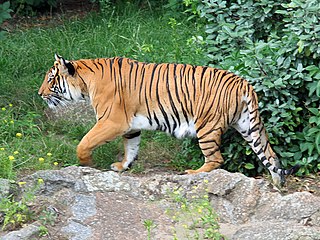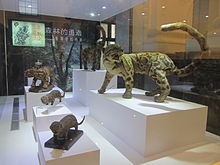
The leopard is one of the five extant species in the genus Panthera. It has a pale yellowish to dark golden fur with dark spots grouped in rosettes. Its body is slender and muscular reaching a length of 92–183 cm (36–72 in) with a 66–102 cm (26–40 in) long tail and a shoulder height of 60–70 cm (24–28 in). Males typically weigh 30.9–72 kg (68–159 lb), and females 20.5–43 kg (45–95 lb).

The clouded leopard, also called mainland clouded leopard, is a wild cat inhabiting dense forests from the foothills of the Himalayas through Northeast India and Bhutan to mainland Southeast Asia into South China. It was first described in 1821 on the basis of a skin of an individual from China. The clouded leopard has large dusky-grey blotches and irregular spots and stripes reminiscent of clouds. Its head-and-body length ranges from 68.6 to 108 cm with a 61 to 91 cm long tail. It uses its tail for balancing when moving in trees and is able to climb down vertical tree trunks head first. It rests in trees during the day and hunts by night on the forest floor.

Neofelis is a genus comprising two extant cat species in Southeast Asia: the clouded leopard of mainland Asia, and the Sunda clouded leopard of Sumatra and Borneo.

The leopard cat is a small wild cat native to continental South, Southeast, and East Asia. Since 2002 it has been listed as Least Concern on the IUCN Red List as it is widely distributed although threatened by habitat loss and hunting in parts of its range.

Yu Shan or Yushan, also known as Mount Jade, Jade Mountain, or Mount Niitaka during Japanese rule, is the highest mountain in Taiwan at 3,952 m (12,966 ft) above sea level, giving Taiwan the 4th-highest maximum elevation of any island in the world. It is the highest point in the western Pacific region outside of the Kamchatka Peninsula. Yushan and its surrounding mountains belong to the Yushan Range. The area was once in the ocean; it rose to its current height because of the Eurasian Plate's movement over the Philippine Sea Plate. Yushan is ranked 40th by topographic isolation.

The Formosan black bear, also known as the Taiwanese black bear or white-throated bear, is a subspecies of the Asiatic black bear. It was first described by Robert Swinhoe in 1864. Formosan black bears are endemic to Taiwan. They are also the largest land animals and the only native bears (Ursidae) in Taiwan. They are seen to represent the Taiwanese nation.

The Indochinese tiger is a population of the Panthera tigris tigris subspecies that is native to Southeast Asia. This population occurs in Myanmar and Thailand In 2011, the population was thought to comprise 342 individuals, including 85 in Myanmar and 20 in Vietnam, with the largest population unit surviving in Thailand, estimated at 189 to 252 individuals during the period 2009 to 2014.

The Pantherinae is a subfamily of the Felidae; it was named and first described by Reginald Innes Pocock in 1917 as only including the Panthera species. The Pantherinae genetically diverged from a common ancestor between 9.32 to 4.47 million years ago and 10.67 to 3.76 million years ago.

Saaroa or Lhaʼalua is a Southern Tsouic language spoken by the Saaroa (Hla'alua) people, an indigenous people of Taiwan. It is a Formosan language of the Austronesian family.

The Sunda clouded leopard is a medium-sized wild cat native to Borneo and Sumatra. It is listed as Vulnerable on the IUCN Red List since 2015, as the total effective population probably consists of fewer than 10,000 mature individuals, with a decreasing population trend. On both Sunda Islands, it is threatened by deforestation. It was classified as a separate species, distinct from the clouded leopard in mainland Southeast Asia based on a study in 2006. Its fur is darker with a smaller cloud pattern.

The Bornean clouded leopard is a subspecies of the Sunda clouded leopard. It is native to the island of Borneo, and differs from the Batu-Sumatran clouded leopard in the shape and frequency of spots, as well as in cranio-mandibular and dental characters. In 2017, the Cat Classification Taskforce of the Cat Specialist Group recognized the validity of this subspecies.

The Taiwanese serow also known as the Formosan serow, is a small bovid that is endemic to the island of Taiwan.
Htamanthi Wildlife Sanctuary is a 2,150.73 km2 (830.40 sq mi) large protected area in northern Myanmar. It was established in 1974 in the Sagaing Region.

The Sumatran clouded leopard is a subspecies of the Sunda clouded leopard and is native to the Indonesian islands of Sumatra and Batu. It differs in molecular, craniomandibular and dental characteristics from the Bornean clouded leopard. It was recognized as a valid subspecies in 2017.

The Amur leopard is a leopard subspecies native to the Primorye region of southeastern Russia and northern China. It is listed as Critically Endangered on the IUCN Red List, as in 2007, only 19–26 wild leopards were estimated to survive in southeastern Russia and northeastern China.

The Indochinese leopard is a leopard subspecies native to mainland Southeast Asia and southern China. In Indochina, leopards are rare outside protected areas and threatened by habitat loss due to deforestation as well as poaching for the illegal wildlife trade. The population trend is suspected to be decreasing. As of 2016, the population is thought to comprise 973–2,503 mature individuals, with only 409–1,051 breeding adults. The historical range has decreased by more than 90%.
Mahamyaing Wildlife Sanctuary is a protected area in Myanmar's Sagaing Region, covering an area of 1,181 km2 (456 sq mi). It ranges in elevation from 145 to 590 m and was established in 2002 in Kalay and Mawlaik Townships.

















